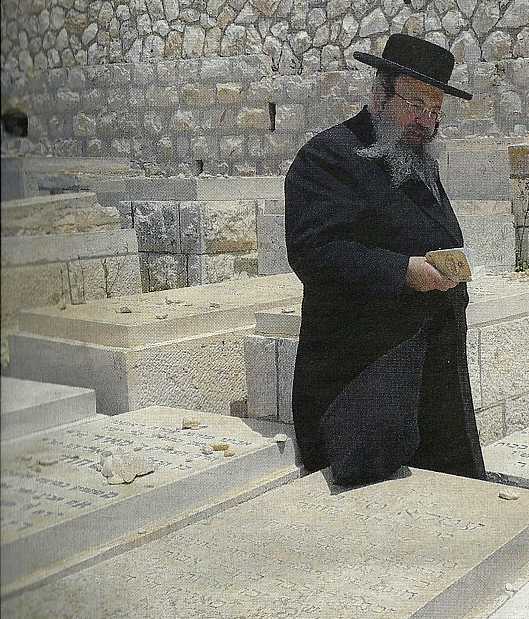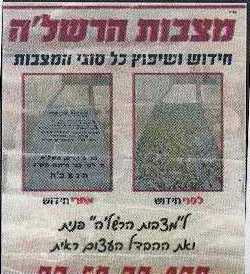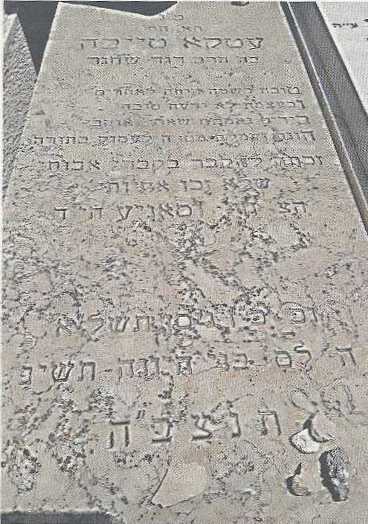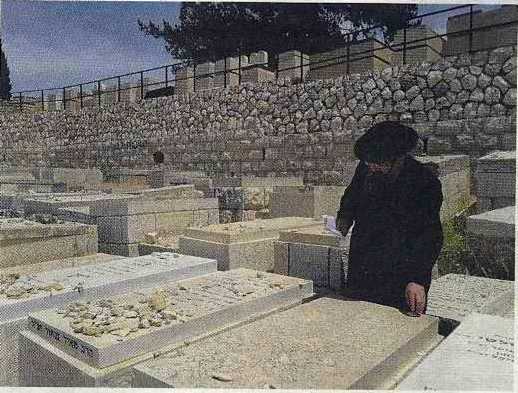Rabbi Dovid Kletzkin is a member of the Yerushalayim Chevra Kadisha. A business flyer that he happened to pick up at a levaya, led to an extraordinary sequence of events that shows how Hashem makes His influence felt in the course of what may appear to be ordinary events.
Rabbi Dovid Kletzkin, member of the Yerushalayim Chevra Kadisha

Rabbi Kletzkin is still deeply moved by the amazing discovery and its timeliness. Every one who hears or reads about it is also moved. Ever since it became public knowledge, the story has aroused much emotion everywhere, having taken place particularly during Sefiras HaOmer just days ago. This is the period when we mourn the 24,000 talmidim of R' Akiva who, by not sufficiently showing respect towards one another, caused Hashem to project special attention of Divine Providence in an event which began a month and a half ago, but whose origin took place some fifty years before.
Rabbi Kletzkin: At a funeral on Har Hamenuchos in which I participated, I noticed a colored flyer lying on the ground. This was at the beginning of Nisan. As I was walking between the gravestones, I noticed an ad printed up by someone who works in tombstone restoration. Since I am also involved in this area, I picked it up and stuffed it into my pocket and continued on with my holy work.
"I returned home from the funeral on Har Hamenuchos and forgot all about the paper in my pocket.
"After Pesach, several weeks later on 26 Nisan (note the date), I attended the funeral of a young man in his thirties who had been staying in a hotel with his father-in-law, and suddenly collapsed and died. He was buried on Har Hazeisim, which is not a very organized cemetery. It rained that day and we wallowed in the muddy ground.
"Upon my return, my wife told me to change into clean clothing. I removed the contents of my pockets and, the following morning before going off to shul, I went through the contents of my pockets to decide what to discard. I saw again the flyer of the gravestone renovator."
His immediate instinct, as he describes it, was to throw it away. "My curiosity got the best of me," he admits, "leading me to give it a second look. On the right side was the photo of a gravestone, very old, under which was written `Before.' On the left was a photo of the same grave after its renewal, labeled `After.' I strained myself to read the small but legible letters on the grave."
The flyer that started things off

It read:
"Here lies Etka Taibeh a"h daughter of Harav Dovid Shachor z"l.
"She had the good fortune to be brought to burial, which her young sisters, Chaya and Sonya Hy"d, did not have."
Since the inscription did not include the name of a husband, and since the woman's sisters had died al Kiddush Hashem, Rabbi Kletzkin surmised that the deceased was a Holocaust survivor who died childless. The last line of inscription read:
"She died on the 27th of Nisan 5731"
"I immediately realized that that very day was this solitary woman's 47th yahrtzeit. I regarded it as a special sign from Heaven, very rare indeed. I went off to daven at the Pinsk -Karlin beis medrash, where I said Kaddish for her soul. Afterwards, I told over the story to our Admor and the group attending the davening that morning. It had a tremendous effect. Several of the men immediately lit candles for her soul. The Admor himself began studying mishnayos for her soul and everyone present joined."
Rabbi Kletzkin wanted to include other Jews in this mitzvah of chessed shel emes, and he related the story on his family's telephone news group and this, in turn, was circulated far and wide. Thousands of people were exposed to it. When Rabbi Kletzkin saw how far this had reached, he decided to call up the advertiser and ask him for more details.
The man explained that he always asked his clients for permission to print a photo of their relative's restored gravestone for advertisement purposes.
"Not surprisingly, I was generally refused. Who wants his relative's tombstone used for publicity? One day, however, HaRav Binyomin Rimmer, son-in-law of HaRav Eliashiv, asked me to restore the marker of a relative, his grandfather's sister. I thought that in such a situation, where there was no close relative, perhaps I would be allowed to use the gravestone for my advertisements. HaRav Rimmer thought that it might benefit the solitary woman and that someone might be moved to do something for her soul, so he consented.
"As a result of this permission, the picture was on my advertisement for twelve years."
Rabbi Kletzkin told the man that indeed, he had discovered it precisely on her yahrtzeit and that he had been able to say Kaddish for her. Mishnayos had been learned for her soul's elevation and tzedaka had also been donated.
Rabbi Kletzkin then called up HaRav Rimmer to tell him of this development and to hear more details about the deceased. This is what he learned:
Etka Taibeh immigrated to Eretz Yisrael in 5694 (1934), before the outbreak of World War II. She was saved in the merit of her self sacrifice.
Her family had lived in Minsk, Russia. Her father, Reb Dovid, became embroiled with the authorities due to a tax problem. The KGB came one night to arrest him. His daughter, Taibeh, began screaming at the officers, "Leave him be. I am the one to blame for the tax evasion. My father has nothing to do with it." They interrogated her for a few moments and then, miraculously, the police left empty-handed. They apparently had no dire need for women laborers in Siberia!
The grave of Etka Taibeh as it appears today, 12 years after restoration

At this point, the family decided that it would be much safer to leave and go to Eretz Yisrael. Taibeh's two sisters, already married, remained and met their death in the ensuring Holocaust.
At first, the family lived in Botei Broide in Jerusalem. After the parents' death, Taibeh moved to central Israel and worked as a pharmacist in a Kupat Cholim branch in Tel Aviv. Eventually, she retired to an old age home, where she dispensed large sums to charity.
HaRav Rimmer said that when he was a yeshiva student in Bnei Brak, he would make an effort to visit his great aunt weekly. Once when he was in Yerushalayim during Pesach bein hazmanim, asked his brother to do so. On Thursday 27 Nisan, his brother arrived, only to find that Aunt Taibeh lay on her deathbed. She had the merit to recite the vidui and declare the Shema with him. She was buried near her relatives, the Rimmers, near her father's grave.
Rabbi Kletzkin: "When I heard this part of the story, I added it on to my family's phone message group in order to strengthen everyone's faith in Divine Providence over every Jew. From there, it spread rapidly to a much broader circle. On the eighth of Iyar this month, I received a call from a Jew who identified himself as Aharon, who had a spine chilling appendix to the tale."
Aharon: "I heard your story last week in a strange way. As soon as I learned the details, I felt shivers running down my back, and I want to share the developments with you, since you are a leading factor in it."
The story began fifty years before when Aharon was a young man. He went to the Kupat Cholim pharmacy in Tel Aviv for a certain ointment for his skin. He came home, only to discover that it was the wrong prescription. Infuriated, he returned to complain, demanding that it be replaced with the correct cream. The pharmacist explained that she could not exchange a prescription that had been already opened.
It turned out that when he had presented his prescription, a person at his side had also presented a prescription and these had been inadvertently interchanged. The other person had noticed the error and exchanged the cream immediately without a problem. But Aharon had already opened his.
"I began shouting and making a scene," Aharon tells Rabbi Kletzkin. "The druggist said that she had not been the one to serve him, but Miss Tovah the pharmacist. At the sound of the uproar, Miss Tovah emerged from a room and I saw that it was she. My pride would not allow me to admit my error and I continued to scream. She did not reply.
"In my rage, I threw the tube on the table and said something terrible: `May your children need to use such a medication!' Silence reigned in the room. Miss Tovah did not react but her face turned red. I saw the other druggist looking at her with pain and empathy. I left in a huff."
A few years passed after this event and Aharon became engaged. One Shabbos afternoon, he was sitting in shul, listening to a shiur in Pirkei Avos. The lecturer began reading about Hillel who saw a skull floating down the river and said: Those who killed you did so because you killed others, and they, too, will meet their untimely death.
He quoted the words of the Rambam: Chazal said that a person is meted in like measure, according to what he did to others. This can be seen time after time, at all times and in all places. Whoever wrongs another person will be punished accordingly in the same way. The Rav added that whoever initiates something that will be beneficial to others, will eventually benefit from it himself because we know that the measure of good is five hundred times as much as that of evil and harm. As the Yiddish saying goes: What one does, one does to oneself. (Vos men tut, tut men zich.)
Aharon was very moved by the words of the Rov. He went around asking everyone he knew for forgiveness for whatever he had done. Every one forgave me. But I did not remember the story with the pharmacist, and so I did not go to ask for her forgiveness.
That summer I married, full of hope for our future. But the years went by, and our home remained empty. We went to doctors and tried all the segulahs. But we remained childless.
One day I happened to pass by that pharmacy in Tel Aviv and I remembered the incident with the cream. I decided to go in and to ask forgiveness from the pharmacist, thinking that maybe that would help me. I went in and asked about her. `Do you mean Tovah Shachor? She has not worked here for several years. She went to an old age home in nearby Gedera.'
At that time I could not immediately go to Gedera, and I again forgot about the matter. But some time later I was driving along the highway and I noticed a sign for Gedera. I decided to try to find the old age home and Miss Tovah. When I got there I was distressed to find out that she had passed away several years ago. They did not know where she is buried, but they knew her name: Tovah bas Dovid Shachor. They noted that she passed away on 27 Nisan 5731, childless.
Despite his best efforts, Aharon could not locate her grave. But he learned and davened le'ilui nishmasah.
Rabbi Kletzkin: This was not the end of the story. About 15 years ago, Aharon woke up one morning with a strange feeling. He looked in the mirror and was shocked to see that his lips were twisted and he looked very strange. His voice had also changed for the worst.
He hoped it was a passing phenomenon. But it did not pass. He went to the best doctors but they could not help him.
His emotional pain was too great to bear. He had been a baal korei in the shul for decades. He used to daven before the amud on Shabbos and on Yomim Noraim. He used to give Torah shiurim. He could not continue doing any of these things, which all added to the tremendous pain of walking around with the disfigurement.
He went to gedolei Yisroel asking for a brochoh. One suggested that perhaps he needed to correct something that was connected to speech. He tried to remember what it could be, but without success. He prayed that HaKodosh Boruch Hu enlighten him.
Then came the sudden yeshua, like a bolt out of the blue.
Rabbi Kletzkin: "On 2 Iyar, 5778, Aharon heard my story of Hashgochoh protis in shul. He heard about the gravestone of Etka Taibeh bas Rav Dovid Shachor and how I had found it on her yahrtzeit. Aharon was stunned to hear that she was buried on Har Hazeisim. For decades he had searched for her grave in the Tel Aviv area, obviously without success.
"Aharon contacted the chevra kadisha in Yerushalayim and they told her where she was buried. He lost no time. He went to Yerushalayim, and paid for a minyan to accompany him to Har Hazeisim. He said mishnayos and Tehillim. Then he took off his shoes and wept bitterly for long minutes.
"Then Aharon said, `I have sinned to Hashem the G-d of Israel and to Etka Taibeh bas Rav Dovid,' according to the instructions of the Shulchan Aruch. Then he asked for selichoh and mechiloh from the bottom of his heart. His minyan responded, Mochul loch, Mochul loch, Mochul loch.
Aharon then went to the Kosel. He felt a heightened spirituality, at having experienced such an individual example of Hashgochoh protis. He davened minchah and ma'ariv, shedding many more tears. He promised Hashem that if he experiences a yeshuah he would publicize it in every possible way.
Then the unbelievable happened! Four days later, on 6 Iyar Shabbos parshas Acharei Mos-Kedoshim (in Eretz Yisroel), Aharon got up, washed his face, and could not believe what he saw in the mirror. His face had become normal. He started to scream and his wife came running in. She could not believe her eyes. When he spoke, his voice had also been restored.
He went to shul dancing on air, knowing that the Healer of all flesh had healed him.
Aharon: "Just that day the Master Play Master had brought it about that the scheduled baal korei had a sudden attack of laryngitis. There was no one arranged to take his place. Aharon got up. He had been a baal korei for decades before his misfortune. He went up to the bimah and began to read, "After the death of the two sons of Aharon..."
"Suddenly all the pain, tension, fear and worry of all those years welled up and he burst out crying, right in front of the entire congregation. It was several minutes before he could continue. Everyone was shocked at the change for the good."
After the tefillah, Aharon announced that he was making a public melaveh malkah after Shabbos, at which he began to fulfill his vow to publicize his miraculous recovery.
With some effort he got the phone number of Rabbi Kletzkin. He told him the sequel and asked him to include his amazing story.

Rabbi Kletzkin
Rabbi Yisroel Rosner, a Yated Ne'eman columnist who is also a member of the Chevra Kadisha Chassidim Yerushalayim, is acquainted with this story firsthand, as he describes it for the readers:
I work together with Rabbi Dovid Kletzkin, both of us who were eye witnesses to the first part of this incredible story, the following parts of which I later heard from him. He told it to me this week because its developments aroused tremendous interest in the public. Several members of the family visited the gravesite of their grandfather on his yahrtzeit and utilized this opportunity to go to the grave of the person who was the cause of much suffering in order to ask for forgiveness.
"People took this story very much to heart since it presents an amazing example of appeasement of tremendous dimension. Family disputes are resolved and we become privy to many similar incidents."
Rabbi Kletzkin has opened a phone line for stories of Hashgocho Protis. It is 972-2-3011300. It is currently in Yiddish and Hebrew.
Aharon has a message: Dear Jews, my friends and brethren. Have you hurt someone? Don't wait for years until it is too late. Ask for forgiveness, even if you believe you were right, so that you do not have to suffer.




